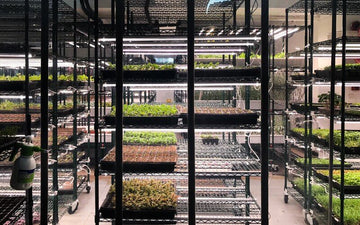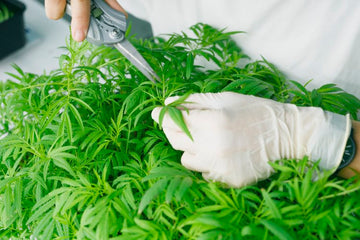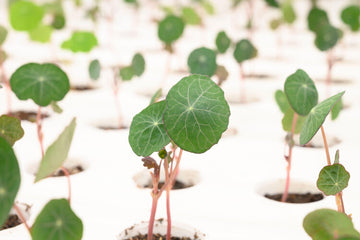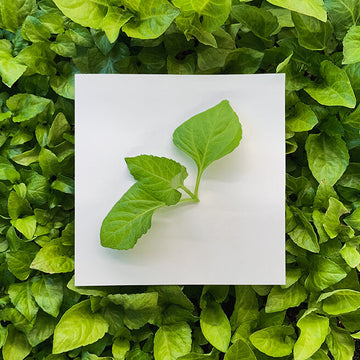Can Urban Farming Make Hong Kong More Resilient in Times of Crisis?
by Rohail Ali on Oct 23, 2023

Seedlings sprouting in the germination zone in our indoor farm - located in the top floor of an industrial building in Hong Kong.
We're currently in the midst of a global food insecurity crisis. The Covid-19 pandemic has exposed severe defects within our supply chains, but while it may have widened the cracks, it isn't the source of the collapse. The capacity for communities to exercise control over their food systems has already been eroded for decades. Industrialization and the conglomeration of smallholder farms to serve the interests of global corporations have left many rural communities behind, and the past several months of global supply chain shutdowns have demonstrated that food insecurity poses a high risk to urban populations as well.
Cities like Hong Kong and Singapore now import over 90% of their food. That's where food sovereignty comes in - the right for communities to choose food systems that work for them.
This risk is all too evident in Hong Kong, where many people had never seen an empty grocery store shelf in their life until a couple of months ago, and are now being forced to reckon with their complete reliance on food systems that they don't understand. Due to a rapid decline in local agricultural production over the past several decades in favor of real estate development, cities like Hong Kong and Singapore now import over 90% of their food.
That's where food sovereignty comes in - the right for communities to choose food systems that work for them, to keep their families and their environment healthy in a sustainable way. It doesn't have to work the same way everywhere. In certain contexts, this can mean a return to more traditional models of community agriculture and re-allocation of farmland for producing culturally significant crops instead of being sold to global corporations.
But what does it mean for a city like Hong Kong, where only a fraction of the population is directly involved in farming, and where there is minimal available land for agriculture?

Harvesting pesticide-free lime basil and yarrow. Growing indoors means we can keep a consistent climate, free from pests.
Increasing support for local farmers and cooperatives is a good place to start, and we've seen a resurgence in the popularity of local farmers' markets. Not only does it give people access to fresher and more nutritious produce, but it also builds vital community awareness and connection to the food system so that we're more conscious of how our future decisions matter.
A next step would be to reconsider the potential for converting under-utilized industrial spaces into indoor farms. Though there is a shortage of farmland in HK, there is certainly no lack of vacant industrial units, and indoor farms in Hong Kong can take advantage of existing infrastructure to increase efficiency in production and distribution.
To make a significant impact, the government can do more to invest in the long term project of improving food security by granting funding to the indoor farming industry in its fledgling stage. Singapore recently announced a $30m fund to boost the productivity of its urban farming sector as a strategy to reduce the city's reliance on food imports. They aim to domestically source 30% of their food by 2030, particularly in the categories of leafy greens, eggs, and fish, which are more perishable and susceptible to supply chain disruptions. Hong Kong would be wise to follow suit, and it would likely prove a popular move as a large portion of the population already supports the localism movement.
In the context of Hong Kong, one of the big pieces of the puzzle has to be future-forward agricultural technologies that allow us to produce high quantities of food in dense urban centers.
To mitigate the risks of global food supply chain interruptions in times of crisis, we should be taking inspiration from food sovereignty movements around the world where communities are reclaiming authority over their food systems. In the context of Hong Kong, one of the big pieces of the puzzle has to be future-forward agricultural technologies that allow us to produce high quantities of food in dense urban centers.
By growing on vertical shelves in our indoor farm at the top of an industrial building, we can produce over 5x the number of greens as we could in an equivalent amount of outdoor space. We deliver directly to our customers who reach out to us directly or through our social media channels - ensuring transparency and trust that we're producing their food in a safe, healthy way. Our customers, both in the F&B industry as well as home consumers, have been to our farms and can verify that their food is pesticide-free and grown on organic soil with nutrients from our highly efficient water re-circulating aquaponic system. Most importantly, we can grow all year round in a climate-controlled facility, without being at the mercy of the typhoons, heat waves, and pests that threaten harvests of traditional farms in Hong Kong.

Educating the next generation about food production is an important step in improving urban food security.
More education and awareness is needed in Hong Kong for indoor farming to gain the traction it needs to blossom. However, based on the reactions we've seen when we run workshops with children and corporations, or deliver our produce to customers, people are inspired to learn more about the food system once they gain a direct connection to the people who grow their food. Helping people create those connections continues to give us the motivation to cultivate this emerging industry in Hong Kong and support the growing movement within our community to re-establish control over its food system.




